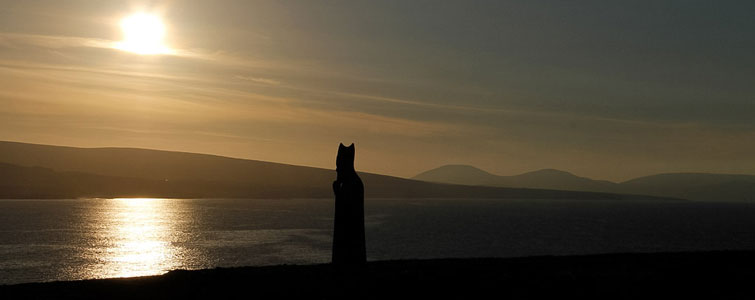Traces of Saint Patrick in Killala, Lacken and Crosspatrick

Patrick visited North-East Mayo, also known as the Barony of Tirawley, many times after he crossed the Moy. In early texts (Tirechan and Tripartite) about his life, the place called “Silva foclutae” is identified with the Wood of Fochill, between Killala Bay and Lacken, where historians believe Patrick spent his period as slave in Ireland herding sheep.
Liam de Paor, a former lecturer in archaeology and history in U.C.D., in his book ‘St. Patrick's World’ (1993) wrote: ”He (Patrick) gives us only one Irish place-name, that of the Wood of Foclut. He implies that it was the place of his captivity. The weight of the evidence is that this was a wood in the West of Ireland, in what is now County Mayo, on the western shore of Killala Bay”.
Here Patrick, in a dream, heard some Irish children begging for his return to covert them to Christianity. St. Patrick in his Confessions wrote: "After a few years, when I was in Britain, my family received me, asked me whether they could trust me now, as a son, never to leave them again. But, while I was there, in a night vision, I saw a man coming, as it were from Ireland. His name was Victoricus, and he carried many letters, he gave me one of them. I read the heading The Voice of the Irish. As I began the letter, I imagined in that moment that I heard the voice of those very people who were near the wood of Fochill, which is beside the western sea, and they cried out, as with one voice 'We appeal to you, holy servant boy, to come and walk among us'. Thank God that after many years the Lord answered them according to their cry".
The Wood was dear to his heart, here he founded many churches including Kilroe, Crosspatrick and Domnahmore, ordained many bishops and performed many miracles.
Here he heard and obeyed the voice of God. God told him to leave his seven books of the law to Bishop Mucna after founding a church for him in the Wood.
To the east of the Wood, at Crosspatrick holy well, west of the church, the conflict with the Tirawley Druids took place. Patrick was baptising some men when the troop of the pagans marched against him.
Reon, one of Druids, declared it was in his power to cause the earth to swallow Patrick as soon as he, Reon, would see him. But Patrick was first to see Reon and so the earth opened to swallow the Druid down. Reon pleaded to save him from death and he’d believe. The earth threw him up and he was baptised.
But another leader of the pagans, called Rechred, was cursed by Patrick. He was lifted high in the air and falling down he died breaking his head against a rock. A fire from heaven burnt his body to ashes.
Near Crosspatrick after his victory over the Druids, he performed other miracles.
Ruan, a poor blind man, son of the charioteer of King Amalgadius, came to Patrick and sought to be cured. Mignae, one of Patrick’s cleric, laughed at him.
Patrick healed the blind man, while the hale became blind because of his mirth. The man became a hermit in Disert-Patraic, a wild wood-lands between Crosspatrick and Killala around Meelick Lake.
At the Wood of Fochill two maidens came to Patrick. They were called Crebriu and Lesru, daughters of Gleru, son of Cummene. In the Wood, some forty years before, he met these two women as children whom he promised to instruct and baptise, theirs were the voices he heard in a dream pleading for his return. They were still there waiting for him, unmarried, with their hearts filled with hope.
After many years Patrick came back to bring them the message of salvation. They received from him the “pallium”, the bridal robe, and they were spouses of Christ for ever. Patrick built for them a small church and a little convent, where they spent their holy lives.
According to the Tripartite, Cell-Foreland was the church located at Teach na n-Druadh, over the Wood of Fochill.
In Killala St Patrick Cathedral, erected in 1680, was built on the site of an earlier church believed to have been founded by the Saint in the 5th century.
Fochill is also a little townland in the parish of Lacken. Here St Patrick’s Well stands. The Well has been a place of pilgrimage for generations, with people travelling long distances to do the stations there. Pilgrims circle around three mounds of earth while reciting prayers and the station ends by drinking water from the well.
A statue of St Patrick was erected in 1936, with the inscription "Erected by the people of Lacken parish, in honour of St Patrick, 1936 Micheal F. Quinn PP”.
